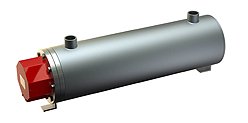Pressure Vessels
Operation Pressure Vessels
Pressure vessels can obtain their pressure from a direct or indirect heat source. The pressure vessels will exert pressure equally in all directions, against all walls of the physical vessel.

Design and Manufacturing Standard
The most common materials used for construction are:
· Carbon steel
· Stainless steel
Pressure vessels are often spherical or cylindrical tanks.
The two main types of pressure vessels are:
1. Vessels designed for end construction
2. Vessels designed for dimensions
Vessels according to end construction can be open ended or they can be closed. Pressure vessels according to dimensions can have a thick shell or a thin shell. Thin shell vessels are designed for tanks, pipes, or boilers while thick shell vessels are meant for tanks gun barrels and high pressure cylinders.
Fabrication of Pressure Vessels
With pressure vessels, operational safety is paramount. As such, the fabrication and design is strictly regulated by engineering authorities due to the high propensity for fatalities.
Today, the manufacturing of pressure vessels follows the steps below:
1. Raw pipe stock must be inspected and upon review, stamped with a tracing number to ensure it can be monitored at all times during the manufacturing process.
2. Examinations are used to verify the minimum thickness of the walls and to ensure all material used maintains its integrity.
3. If it is required, grinding can be used to remove imperfections or to polish the interior surface.
4. The pipe is then cut to length.
5. Precise induction heating is used to form the pipe ends.
6. The vessels are then heat treated inside of a calibrated and controlled center.
7. The vessels endure liquid quenching to ensure all physical properties are in accordance with regulatory demands.
8. The hardness is tested and the results of the heat-treating process are confirmed.
9. The vessel ends are properly treated.
10. The service pressure, water volume, and weight are tested in conjunction with verification of heat treatment, inspection for leaks, and elasticity measurements.
11. After internal steam cleaning to remove any moisture, the internal service is cleaned and the exterior surface is treated.
12. Upon completion, the exterior coating is completed to customer specifications and the final unit is ready for shipment.
Also read: 4 Types of Pressure Vessels Based on Industrial Use
Uses of Pressure Vessels
Pressure vessels can be used in the private sector as well as industrial sectors. Domestically they are common as hot water storage tanks or compressed air receivers. They are also used as diving cylinders, distillation towers, recompression chambers, and pressure reactors for many industries.
Oil and Petrochemical Uses
The pressure vessels used in oil refineries and petrochemical industries often push the design limits in an effort to maximize production and utilization. In the oil refinery industry, pressure vessels are employed in a plethora of services, for myriad of purposes.
· Slug catchers can be used to contain liquid slug from pipelines. Their incorporation can promote the efficient separation of solid particles from liquid particles.
· Accumulator bottles can be used for offshore oil and gas operations.
· Dehydrator vessels can be used to remove minute particles from oil production and chemical processing which were overlooked during the initial separation process.
· Other vessels include packaged vessels, trayed vessels, autoclave vessels, phase separators, and gas absorber vessels.
